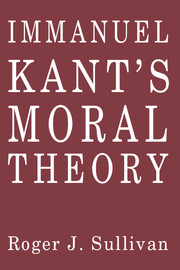Book contents
- Frontmatter
- Contents
- Preface
- Key to abbreviations and translators
- 1 Introduction
- 2 The context for Kant's moral philosophy
- Part I The nature of morality
- Part II The moral norm for persons
- Part III The norm for moral judgment
- Part IV Kant on history, politics, and religion
- Appendixes
- 1 Kant's two-viewpoints doctrine
- 2 Kant's philosophy of moral education
- Notes
- Bibliography
- Index of names
- Index of subjects
1 - Kant's two-viewpoints doctrine
Published online by Cambridge University Press: 05 June 2012
- Frontmatter
- Contents
- Preface
- Key to abbreviations and translators
- 1 Introduction
- 2 The context for Kant's moral philosophy
- Part I The nature of morality
- Part II The moral norm for persons
- Part III The norm for moral judgment
- Part IV Kant on history, politics, and religion
- Appendixes
- 1 Kant's two-viewpoints doctrine
- 2 Kant's philosophy of moral education
- Notes
- Bibliography
- Index of names
- Index of subjects
Summary
In this brief discussion I intend only to try to clarify, particularly for readers not already experts in Kant's theory, some of the kinds of problems typically associated with Kant's noumenal-phenomenal distinction.
Kant used two different methods in his moral writings. In one, the analytic method, he studied the “common knowledge” of morality of ordinary people, to make clear what is contained there. In the other, the synthetic method, he drew on doctrines and definitions he had already developed to explain the nature of human morality. Depending on which method he is using, Kant tends to use the terms “freedom” and “heteronomy” in two very different senses.
“Morally indifferent” freedom
When he reflects on ordinary moral thinking, Kant holds, in effect, that there are three kinds of agents and actions:
First, there are those changes caused by nonrational agents, such as chemical reactions and the movements of animals. They are all the effects of – reactions or responses to – stimuli from other causal agencies that are the effects of still other causes, and so on, and so they are all governed by laws of causal necessity. (See Gr. 97/447.)
Second, there are those actions, examined in Chapter 4, performed by rational agents to attain pleasure or avoid pain. In such conduct, we act on maxims of conduct that can help us satisfy our needs and inclinations. Consequently, whatever the moral legality of prudential actions, Kant calls them all “empirically conditioned” and “heteronomous,” because we are pathologically affected yet still independent of pathological, causal determination.
- Type
- Chapter
- Information
- Immanuel Kant's Moral Theory , pp. 279 - 286Publisher: Cambridge University PressPrint publication year: 1989



